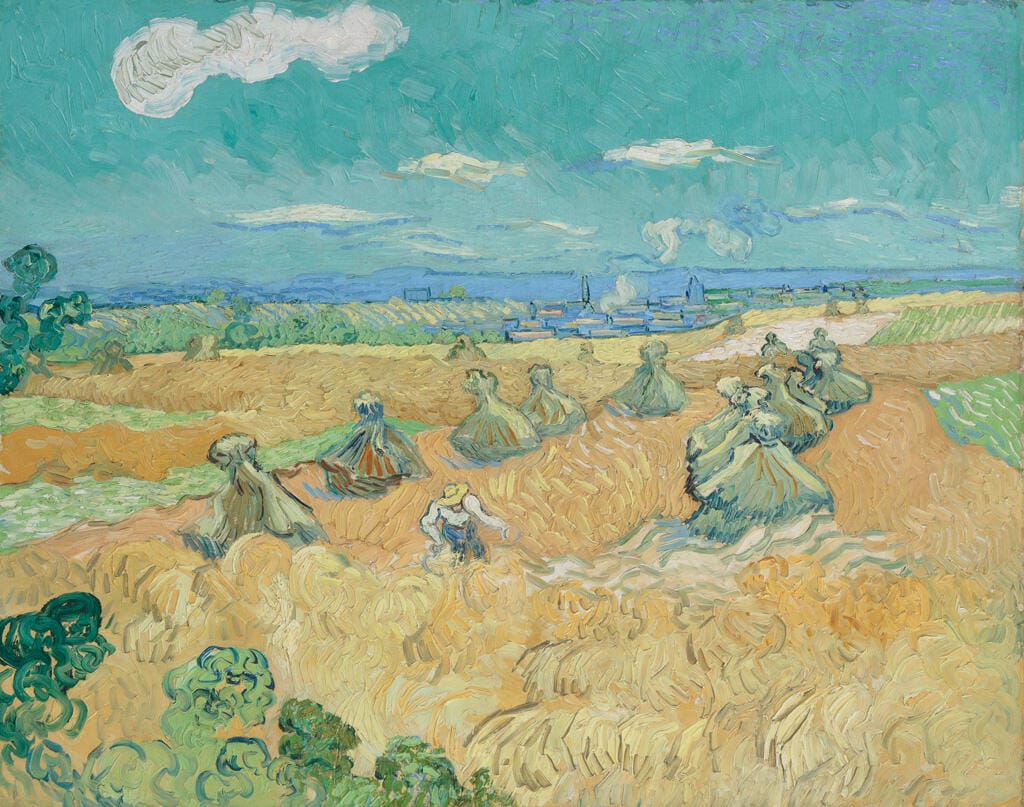Capturing Moments in Time: Sophie Matthiesson on ‘A Century of Modern Art’
A Century of Modern Art is yours to explore at Toi o Tāmaki until 28 September 2025.

In the reclaimed serenity of Auckland Art Gallery following a busy opening weekend, Craccum spoke with Dr Sophie Matthiesson, Senior Curator of International Art, about the new exhibition of iconic paintings that have journeyed all the way from Toledo, Ohio. As we moved through the space to stop in front of masterpieces, so too did our conversation, meandering from art’s evolution in the wake of new technology to the ongoing human pursuit of documenting and decoding the world through images.
Judy: To begin, could you share a bit about your journey and how you brought this exhibition to Tāmaki Makaurau?
Sophie Matthiesson: A Century of Modern Art is a touring exhibition of Impressionists right through to Pop artists. I have always specialised in international shows like this one – I spent 13 years as a curator at the National Gallery of Victoria before joining the Auckland Art Gallery.
As the host institution for this exhibition, we’ve been working closely with Erin Corrales-Diaz, Curator of American art at the Toledo Museum of Art in Ohio who proposed the concept and checklist. I started with her ideas and translated them forward into multiple levels of interpretation within the exhibition space. So your ticket brings you not only an amazing lineup of artworks from an eminent collection in America, but also your room brochure, wall texts and labels, and access to an audio guide. There’s a whole set of public programmes and lecture series offered alongside the show as well. You could spend your entire winter in the Gallery uncovering new layers in this exhibition.
Museums offer inclusive experience and the beginning of a dialogue, through the artworks as well as through the exchange of ideas between professionals as they work together. It’s very enriching to be on the team behind these kinds of shows.
J: Do you feel like there are any misunderstood or overlooked aspects of curating?
SM: Well, there’s a lot of layers to any show. We’ve just got such a wide, wide audience, from children to people with learning disabilities and all sorts of experiential challenges. How do you convey a show like this to the partially sighted? How do you convey the paintings representing soundscapes and music to people who are auditorily challenged? It’s very much a collaborative effort with the designers and specialists in our public programmes teams to turn one exhibition into a versatile offering that can benefit as many people as possible.
J: Speaking of audiences, this exhibition features many big names including Monet, Degas, and Van Gogh. How do you balance your experience as senior curator with the kind of expectations visitors might bring with them?
SM: In this particular example it’s very easy because the Toledo Museum of Ohio has always had a policy of buying the best of the best. If you come to this show you’ll see the very best of Van Gogh. One of the most large-scale and sublime water lily paintings by Monet at the height of his powers. One of Gauguin’s earliest Tahitian scenes. You’ll see a superlative example of those big-name artists. Toledo has a super high quality collection, only it hardly ever travels as a group. The Monet, for example, is so large you would almost never bother to lend it because it requires a huge air freighter. It’s a huge privilege to work with these pictures and to have them under one roof at the same time.
J: That must have been a lot to organise. Did you run into any crazy logistical predicaments?
SM: I haven’t personally had any crazy moments, and transporting paintings doesn’t pose the same challenges as sculptures can. But having said that, it’s not always a case of hopping in a plane and airlifting them from A to B. The first shipment was delayed at the airport and one of the couriers from Toledo Museum had spent almost 30 hours on the road, escorting the works from the Midwest to New York by truck… she was just utterly exhausted.
J: The word “Modern” here refers to the art period between the late 19th and 20th century. We’re a fair distance from that chronologically, but do you think there are any questions or desires pursued by the Modern painters that are still relevant today?
SM: Oh, yes. There’s the ongoing challenge of seeing the world with new eyes, breaking with learned ways of looking and thinking. Sometimes you have to be shown how to do it. The Impressionist movement came about because enough like-minded people began creating works which challenged conventional perception at the same time.
Another important aspect is experimentation with new materials. This exhibition witnesses a number of leaps in technology: the introduction of new colours like mauve, painting on ready-stretched canvases instead of the artist having to stretch them out themselves, aniline dyes in the late 19th century. The invention of the train system in the 1840s meant artists could travel to distant places quickly, bringing portable equipment like paint tubes – that was all newfangled, all freshly innovated for the growing trend of painting outdoors in the countryside. Morris Louis works with a paint maker in the 1950s to make paint acrylics more runny and thin so that he can trickle them.
We have had similar technological changes that have enabled us to transform art in our time. The age of the computer in particular. Generative AI. And the, what, NFTs? I hardly know what some of this stuff is [chuckles].
J: How then do you see the role of galleries evolving, especially in this post-digital world where art and media is so accessible and so quickly made (and consumed)?
SM: We are actually making a strength of being the opposite. Slow looking. A direct connection to a work of original art. A lot of the works in this exhibition are glazed so you can actually come up close to see how they’ve been made. This is an immersive kind of show, it’s not a quick fix. Generally speaking, it takes over an hour to see it all. There’s something pure about a show comprised of only paintings. It isn’t high stimulation in the sense that there are lots of objects sitting there, but each artwork has been given its own contemplative space. I think that acts as a bit of an antidote against quick consumption.
Our conversation migrates through to the next room, and true to Sophie’s word, there is something cathedral-like in the way the huge Monet water lily painting is cradled by abundance. Each frame bears the legacy of a visionary artist, each wall a gathering of contemporaries. The doorway we arrived through has a Gauguin on one side, a Van Gogh on the other – “two best friends who admired each other hugely.”
J: I’m reminded of the international Van Gogh Alive multisensory experience which came to Auckland a couple years ago that was all over social media. It seemed as though the whole point eventually became to snap pictures of yourself there and share them online.
SM: Yes, that’s really the perfect counter example. I’ve never been to one of those shows but I feel like I ought to, because it costs quite a lot to go to and there’s not a single authentic experience in there, in the sense that there’s no original work of art. It’s a bit like Baudrillard’s idea of the original having been replaced by simulacra, by replicas and reproductions. But here [in this exhibition] we have only the original. Coming to a show like [A Century of Modern Art] is a chance to realise mass production can’t give you the proper experience of, for example, the Van Gogh painting. You’ll never see a reproduced image of painting which gets the colours right. For some reason it’s a very difficult picture to photograph.
There is a special experience standing in front of a work of art. For me, it means a community. It means I can look at the painting by Monet and imagine we are in Giverny. Clemenceau, the French Prime Minister, would hop off the train to see these pictures in production and discuss the fact that they should be given to the French nation. His work ends up being in the Musée de l’Orangerie where people are making a pilgrimage to see them.
I also think about how Cézanne painted with Pissarro, whose enormous influence is visible in Cézanne’s brushwork. Whistler and Courbet painted together in Normandy; I can think of three artists who captured that particular spot that same summer. Van Gogh and Gauguin in Provence. These paintings weren’t made in a vacuum at all. Each one represents a relationship with another artist, a community of artists who were not necessarily imitating each other but paying attention to what everybody else was doing.
You could interpret this room as an escape from modernity. These artists all left Paris, repelled by the Eiffel Tower and the emphasis on wealth and industrialisation, going out on picnics to paint together, searching for utopia.
J: The Impressionist artworks are quite popular among audiences, why do you think they are so beloved?
SM: I think there’s an immediacy of response to the seen world, to colour, atmosphere, weather, transient effects. These are pictures that are grounded in experience and observation, not in history, in morality, or in strong messaging – it’s about living in the moment. I do believe it’s a pernicious effect where we regard Impressionism as being simply pretty. That’s the last thing it was at the time, the Impressionists were not attempting to create a new canon of beauty. They were rigorously engaged in experimentation and colour theories, and were politically involved too. A lot of advertising about Impressionism will tell you things like ‘Monet was only an eye, but what an eye,’ whereas in fact, he kept political journals and held political opinions that were considered to be quite subversive. We’ve depoliticised the Impressionists and turned them into something pretty to commodify. That is something we have to work against.
The latter half of the exhibition moves towards abstraction, revealing an experimental emphasis on texture, angular geometry, striking planes of complementary colours, and new methods of painting. These rooms are charged with a hushed energy.
J: The artworks become less representational as the Modern period progresses. I think some audiences might find it harder to “get it” or feel that the art is more for the artist and not for the viewer. Could you share your take on that?
SM: Very good question. You do get these very cryptic messages. I think that abstraction does not come naturally to many people. We all read each other’s faces and behaviours, understanding the world through visual signs. It is really difficult to free yourself from that sign-related habit of learning and understanding to attempt what the Bauhaus artists wanted us to do: to just respond to colour, relationships, and forms. To be entirely free of recognisable subjects, narrative, or any prescribed meaning. To be aware of no thing but art.
I think that in these rooms here, the artists are trying to remove art from the realm of the everyday. They are simply immersing us in sensations, unlearned sensations. This is about art propelling us into other avenues of expression in ways untrammelled by ideas of decorum and convention. In both the Ad Reinhardt and Hans Hofmann, for example, there’s no story being told. But the paintings are intensely dynamic, the colours are pushing against each other, every area is an essay in texture. All these artists would say that abstraction is the purest form of painting.
The artworks most definitely appear to be different across art periods, yet many of the same elements continue to be used: working with pure unmodulated hues, not trying to control how the oil paint behaves, allowing accidental effects to happen. These are all ways of exploiting spontaneity and chance effects that the Impressionists and Surrealists used as well.
J: Fascinating. Do you have a personal favourite in this exhibition?
SM: I do, and I don’t think it’s going to change – the Van Gogh. You could hardly get a better expression of a high summer day in rural France. It’s that sense of being at one with the world; the richness, the wholesomeness of the wheat fields, and the clouds racing past in the turquoise sky. I just think it’s the most amazing painting, one of his last paintings produced in the days before he died. The story is that he shot himself out in the fields in July 1890, but there were local boys bullying him and no one knows how he got a gun. In any case, I don’t think that the painting reflects suicidal ideation. It’s the most sublime, beautiful, uplifting painting that suggests that Van Gogh had many more years of life in him. He had a very rough life, but I just think that he was a bit of a phoenix who kept rising again.
J: How would you go about describing this exhibition to, say, an extra-terrestrial who has never encountered human art before?
SM: Well, this is a show about artists who used colour and paint to create a genuine expression of their time. Each of these artists managed to do that without looking back or being constrained by what came before – many were released by what came before. What I’ve seen in this exhibition is how human beings and their art unfolds like a chemical reaction. A fuse is lit at the beginning of the show, then one idea gives way to further breakthroughs. Now, I don’t know how an alien would relate to that concept, but it tells me that human beings can always evolve. We can always find ways of being in the moment and responding in ways nobody else has done before.
These artists invented the imagined worlds they wanted to occupy. Pierre Bonnard painted the Mediterranean as if it’s paradise on Earth. The paintings by Claude Monet, Hans Hofmann, and Josef Albers were all produced in old age when these artists had retired into a second lease of life. Monet painted hundreds of water lilies. Albers painted Homage to the Square because he wanted to capture the full gamut of effects achievable by manipulating proportions of squares and relationships of colour. He made thousands of permutations, much like Bach’s preludes, fugues, and variations – just trying to push one idea to its extreme. It’s one of the most amazing things, that glory of old age when you’ve got the freedom to pursue an idea to its very, very end point.
J: Does art always require some kind of pushing back, being different to what came before, in order to evolve?
SM: Sometimes it’s just allowing the world to start to creep in again, if it’s been eliminated. A bit like nature reclaiming cities. There’s something quite reassuring about it.





